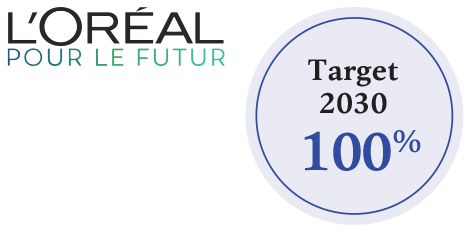Suppliers are also asked to make use of sustainable sourcing certifications adapted to their stream (Fair Trade, Sustainable Agricultural Network, Organic etc.).
By adopting a sustainable sourcing approach for bio-base draw materials, L’Oréal contributes to the social and economic inclusion of vulnerable population groups while respecting the environment. In 2022, the proportion of sustainably sourced bio-based ingredients was 92%, showing a slight decrease due to the ongoing improvement in the traceability of the bio‑based portfolio and the updating of countries at risk via the Scan Index in line with the development of each geopolitical context.
In 2022, 92% ☑ of the biobased ingredients in our formulas were traced and sourced from sustainable sources(1).
Target2030 100%
(1) For the definition of the scope see the Methodological Notes.
☑ The Statutory Auditors have expressed reasonable assurance about this indicator.

In 2022, 92%☑ of the biobased ingredients in our formulas were traced and sourced from sustainable sources(1).

Rice bran oil: improving resilience to climate change in Thailand
L’Oréal uses rice bran oil from Thailand for its anti-dandruff and antioxidant properties (haircare and skincare products). In Thailand, rice production accounts for a total of 4 million hectares, representing around 20% of the country’s agricultural land. As the world’s fifth largest producer of rice, Thailand is also one of its leading exporters. Rice production is therefore one of the main pillars of the local economy, although the monoculture of rice has a negative impact on the environment.
In 2016, L’Oréal launched a project for the responsible sourcing of rice bran from small producers in the Isan region in north-eastern Thailand. L’Oréal works with the PUR Projet NGO and its suppliers to support four producer cooperatives in implementing climate-smart practices in order to reduce the amount of methane produced by the region’s rice farming and to improve its resilience to climate change. In this context, four plots were established to provide
full‑scale demonstrations of agricultural techniques. The practices presented in the demonstration plots include:
- the cessation of ploughing to preserve the different soil horizons and maintain their capacity to sustainably retain water;
- agroforestry on the edge of rice fields to encourage the diversification of farmers’ incomes and improve the surrounding biodiversity;
- the adoption of the System of Rice Intensification (SRI) to reduce the use of water and limit methane emissions;and
- the smart use of water to improve adaptation to droughts.
Thanks to the determination of volunteer farmers, the project has successfully demonstrated the benefits of regenerative agriculture to the agricultural community, in particular how carbon sequestration and the protection of biodiversity can significantly increase yields and improve their livelihoods.
L’Oréal strongly encourages as many farmers as possible to adopt SRI practices. In 2022, 1,186 local producers benefited from the project, 59% of which were women.
Respecting biodiversity and measuring our impact
The loss of biodiversity undermines food security, health, quality of life and many services provided to our economies(pollination, the purity of air and water, soil fertility). It also effects the Group’s resilience to climate change. The conversion of natural ecosystems for agricultural and urban development purposes is recognised by science as the primary factor for the loss of biodiversity, followed by pollution, climate change and the introduction of invasive species.
The Group has a long-standing commitment to the preservation and sustainable use of biodiversity. The L’Oréal for the Future programme reaffirms this commitment by placing biodiversity right at the heart of its goals.
The Group has worked with The Biodiversity Consultancy to develop an innovative way of measuring the impact that its industrial activities and sourcing have on natural ecosystems.
This new indicator is based on three parameters: the ground surface required, the loss of biodiversity related to Group practices and the significance of biodiversity in the ecosystem concerned. It estimates that sourcing plant-based ingredients accounted for more than 80% of our biodiversity footprint.
L’Oréal is therefore committed to ensuring that, between now and 2030, its footprint on the ecosystems required to produce its plant-based ingredients remains unchanged from 2019 levels. The following drivers have been identified as key to achieving this goal:
- the adoption of regenerative agricultural practices by suppliers, in order to improve yields, preserve biodiversity and help farmers transition towards more sustainable agriculture;
- the implementation of an ambitious plan to develop alternatives to the raw materials with the highest impact, particularly through biotechnology and circular processes, as part of the Green Sciences programme; and
- support for rehabilitation projects for ecosystems adjacent to our strategic supply chains.
